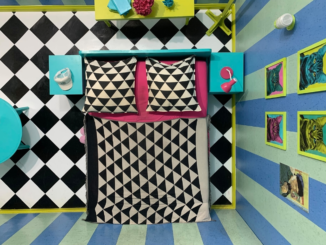By Jake Mahr
Arts Editor
Ra Ra Riot’s name says everything about the band: it produces fun and lively music that is easy to dance to. But after six years, the band’s string-based baroque pop has begun to unfortunately blend their songs into one large mess of catchy choruses, bouncy guitar riffs and emotional strings.
Luckily enough, the group members seem to have realized the rut they were stuck in and have made a drastic change. On their third studio album, “Beta Love,” Ra Ra Riot has toned down the strings and has turned up the keyboards, pushing itself into the realm of synthpop. While this change shows great evolution within the band’s instrumentation, Ra Ra Riot still holds true to its upbeat, foot-moving tracks.
Ra Ra Riot currently consists of vocalist Wes Miles, bassist Mathieu Santos, guitarist Milo Bonacci, violinist Rebecca Zeller, and drummer Kenny Bernard. The group recently lost cellist Alexandra Lawn, which probably contributed to the shift in instrument choice. Ra Ra Riot produced two studio albums, “The Rhumb Line” and “The Orchard,” prior to “Beta Love.” Both achieved general critical acclaim.
The album’s opening track, “Dance with Me,” immediately reveals that “Beta Love” is not the Ra Ra Riot everyone is used to. It begins with Miles’ vocals and a pulsing keyboard. The song then revs up and stacks keyboards, synthesizers, steady drums and a funky bass line. “Dance with Me” flawlessly sets up the faster tempos that continue to run throughout “Beta Love.”
The title track of the album is not only a hysterical version of a love song, replacing people for robots (featuring the lyrics: “I might be a prototype/ but we’re both real inside,” and “In this city of robot hearts/ ours were made to be”), but it also exhibits some fine tuning in Miles’ vocal range. The falsetto notes he reaches during the chorus of the song are incredible for any man and show that the group is still trying to figure things out in their new genre, using experimentation to see what sounds right.
Ra Ra Riot’s evolution is so complete on “Beta Love” that Zeller’s presence is barely noticed until the fifth song, “For Once.” The strings give a little hint back to the old Ra Ra Riot’s sound and are placed perfectly in the album because they give the listener a chance to realize how Ra Ra Riot has changed on “Beta Love.”
The group hits its first hiccup on the album’s seventh track, “What I Do for U.” The song starts with a heavy, incredibly low-toned dance bass, which is then accompanied by high-pitched singing from Miles. The two opposite levels of the volume range really do not mix well. Ra Ra Riot obviously still has some kinks to work out if the band wishes to continue with the synthpop genre.
The other major issue with the album comes from its greatest strength. While individually the tracks sound as if they are Ra Ra Riot on a whole new level, the album as a whole unfortunately melts together. Each song consists of similar-sounding upbeat keyboards and synthesizers, falsetto vocals, and simplistic, loud thumping drums, causing them to mesh together.
“Beta Love” makes listeners want to get up and dance. It exhibits an entirely new side to Ra Ra Riot, and while the album overall may show very little deviation, the individual tracks themselves provide for some of the liveliest tunes the group has ever produced and exhibit their success in attempting and conquering an entirely different genre.

“Beta Love is available in retail stores and on iTunes for $9.99.




Leave a Reply